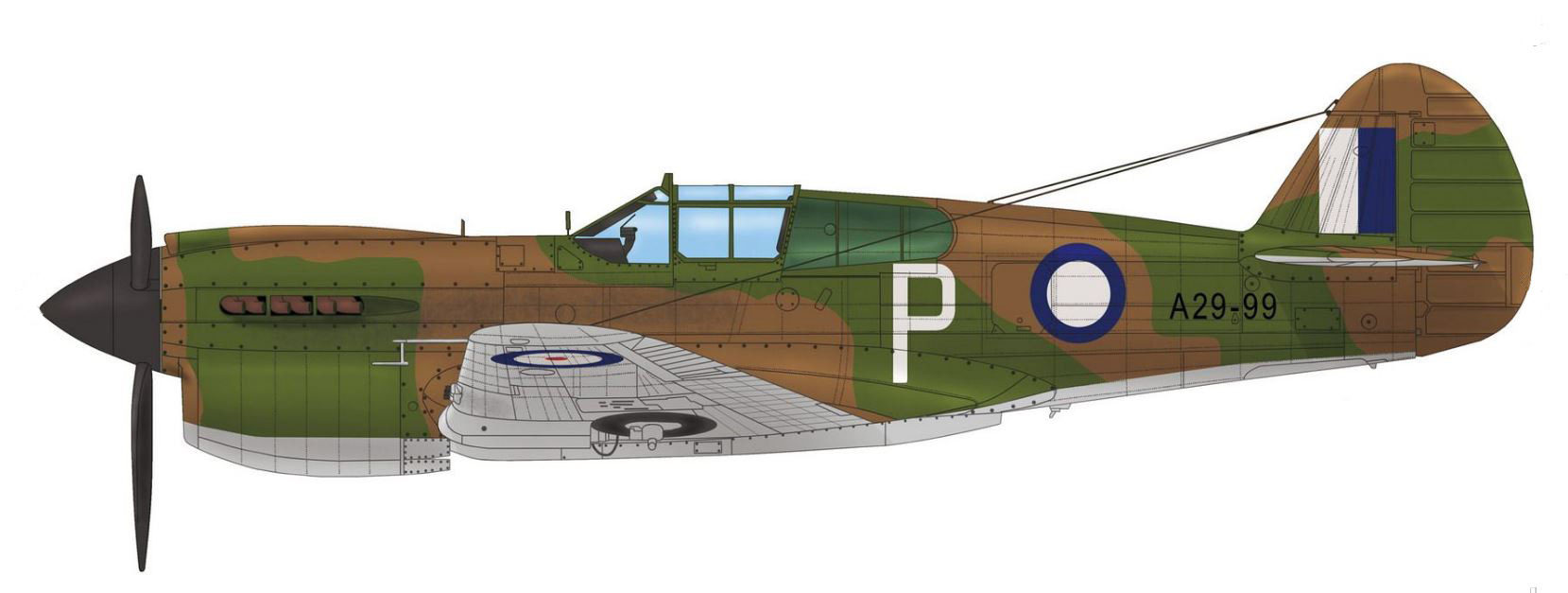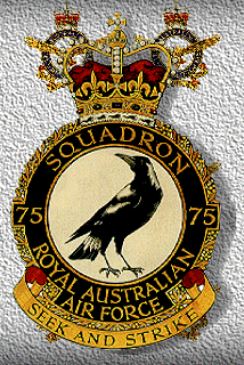Difference between revisions of "No. 75 Squadron RAAF"
From Our Contribution
(→Flight crew) |
(→Trainee Air crew) |
||
| Line 39: | Line 39: | ||
* 1 x Mentined in Despatches | * 1 x Mentined in Despatches | ||
| − | === | + | ===Air crew=== |
* [[Edward Harry Tasker]] 3 Jul - 4 Nov 1945 | * [[Edward Harry Tasker]] 3 Jul - 4 Nov 1945 | ||
Revision as of 23:13, 28 April 2022
 Curtiss Kittyhawk Mk IA of No. 75 Squadron RAAF - Aug 1942 | |
 | |
Brief History
75 Squadron was formed at Townsville on 4 Mar 1942, but it wasn't until 14 Aug 1942 that flight training commenced, albeit only at a rudin1entary level. However, with the Japanese advance, the Squadron was deployed to Port Moresby quickly and on 21 Mar 1942, the first four aircraft landed at the Seven Mile Strip, Port Moresby, and one of them shot down a Japanese reconnaisance aircraft that afternoon. The rest of the Squadron joined them later that day. The following morning a surprise attack was mounted agaist Japanese aircraft on the ground at Lae with great success.
Over the next 44 days the Squadron lost 24 aircraft and 12 pilots, but in return destroyed 60 enemy aircraft in air battles. The Squadron returned to Townsville before moving to Kingaroy and Lowood to complete re-equipmenl and recuperation. The aircrew strength was supplemented by pilots who had seen service with Spitfire squadrons over Europe before 75 Squadron flew to Gurney Field, Milne Bay, where it joined 76 Squadron on 21 Jul 1942. On 8 Aug 1942 the Japanese launched their first air raid in support of a planned landing by thier troops (24/25 August 1942) tasked with capturing the airfield. In addition to covering the base from the air they also carried out attacking and harasing raids against Japanese landing craft and troops thropughout the battle. The efforts of the fighter squadrons were seen by many to be 'the decisive factor' in the ultimate voctory over the invading Japanese forces.
With victory at Milne Bay complete by September 1942, 75 Squadron withdrew south to Hom Island in November before deploying to Cairns. They returned to Milne Bay in January 1943 before moving to Goodenough Island in July 1943. Three months later the Squadron moved west to Nadzab, where it flew close escort missions for US Liberator and Mitchell strikes along the nrthern coast of New Guinea, and tactical strikes on support of Army
operatlons Other duties included defens1ve patrols along the Markham Valley. The Squadron's next move was to Cape Gloucester on New Britain
Here the Kittyhawks flew dose support missions to assist ground troops, in addition to anti-shipping and convoy protection patrols. The ground crew of 75 Squadron were among the first to land at Aitape where they assisted, often under enemy sniper fire, in the rebuilding of the Tadji airstrip, from which the Kittyhawks operated during May 1944. This landing was designed to give aerial protection for the landing at Hollandia and to isolate the Japanese forces operating in the Wewak area. The Squadron was called forward to Hollandia in August, where it remained for two months. When United States forces landed at Biak, the Kittyhawks or 75 Squadron formed part or the covering force for the invasion.
When the landing forces consolidated on Biak, 75 Squadron began operations from the island, dive bombing Japanese soldiers ensconced in caves and bunkers and interdicting barge traffic attempting to reinforce the Biak garrison. The Squadron deployed to Noemfoor after it was captured by US forces, and from here they undertook long range patrols seeking enemy barges and interdicting airstrips at Ceram and other sites in the Halmaheras.
The Squadron returned to Biak for a matter of weeks before deploying to the newly captured island of Morotai. From Morotai it operated over the Halmahera Islands.
The 75 Squadron ground crew were part of the advance force which landed at Tarakan in May 1945. It was intended that they prepare the airstrip to allow the Kittyhawks to fly in two days after the invasion, but the airfield was not serviceable until mid-July. The men often under fire from Japanese light artillery and snipers during this time. When the aircraft flew to Tarakan i was a five hour flight and they arrived with almost empty fuel tanks. The formation was split in bad weather and four aircraft were lost after running out of fuel. From Tarakan, 75 Squadron operated in a interdictory role, bombing japanese fnciiJties near Sandakan and supporting the Australian landings at Balikpapan. After the Armistice the Squadron undertook general flying and reconnaissance llights over prisoner of war camps. The aircroft were flown back to Oakey in Queensland, while the ground crew returned to Australia aboard HMS Glory arriving in Sydney in December 1945.
Individual Honours
- 5 x Distinguished Flying Cross
- 1 x Distinguished Flying Medal
- 1 x Distingushed Service Order
- 1 x Mentined in Despatches
Air crew
- Edward Harry Tasker 3 Jul - 4 Nov 1945
Notes
Content has come from Units of the Royal Australian Air Force - A Concise History - Volume 2 Fighter Units - Australian Government Publishing Service - 1995 pages 40 - 46